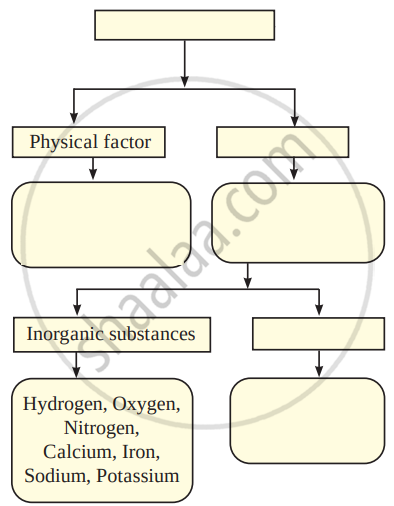Advertisements
Advertisements
Question
Describe the processes and products of decomposition.
Solution 1
The steps of decomposition are fragmentation, leaching, catabolism, humification, and mineralization.
a. Fragmentation: Detritivores like earthworms break down detritus into smaller fragments or particles.
b. Leaching: In this process, water-soluble inorganic nutrients percolate into the soil horizon and get precipitated as unavailable salts.
c. Catabolism: The bacterial and fungal enzymes degrade detritus into simpler inorganic substances. All of the above steps occur simultaneously.
d. Humification: It leads to the accumulation of a particularly decomposed, dark-coloured, amorphous, a colloidal organic substance called humus. Humus serves as a reservoir of nutrients. It is resistant to microbial action and undergoes decomposition at an extremely slow rate. Humus changes the soil texture and increases the capacity of water holding in the soil.
e. Mineralization: Some microorganisms degrade humus and release inorganic nutrients by the process of mineralization.

Decomposition cycle
Solution 2
The various processes involved in decomposition are as follows:
- Fragmentation: It is the first step in the process of decomposition. It involves the breakdown of detritus into smaller pieces by the action of detritivores such as earthworms.
- Leaching: It is a process where the water-soluble nutrients go down into the soil layers and get locked as unavailable salts.
- Catabolism: It is a process in which bacteria and fungi degrade detritus through various enzymes into smaller pieces.
- Humification: The next step is humification, which leads to the formation of a dark-coloured colloidal substance called humus, which acts as a reservoir of nutrients for plants.
- Mineralisation: The humus is further degraded by the action of microbes, which finally release inorganic nutrients into the soil. This process of releasing inorganic nutrients from the humus is known as mineralization.
Decomposition produces a dark-coloured, nutrient-rich substance called humus. Humus finally degrades and releases inorganic raw materials such as CO2, water, and other nutrients into the soil.
APPEARS IN
RELATED QUESTIONS
List two natural ecosystems.
Why is a lake considered to be a natural ecosystem?
Give examples of any two ecosystems.
Which of the following is an artificial ecosystem?
(a) pond
(b) crop field
(c) lake
(d) forest
What do we learn from the story of Jadav Molai Peyang?
What are the meanings of following symbols? Write your role accordingly?

Describe the following pictures.

Annual rainfall in the area of deciduous forest is
Complete the concept map.

Why is it said that pollution control is important?
Among the following choose the correct option which contains only biodegradable items?
- Wood, paper, PVC
- Paper, seeds, detergent,
- Paper, animal excreta, wood
- Wool, leaves, paper
______ are self-nourishing components of the ecosystem.
Fish and other water creatures and plants are maintained in the terrarium.
If we protect the ecosystem, we can reduce waste by using durable goods.
Which one of the following is an artificial ecosystem?
Complete the following chart related to the components of the Ecosystem.

Give an example of a food chain.
Explain BOD and its effects on aquatic ecosystem.
